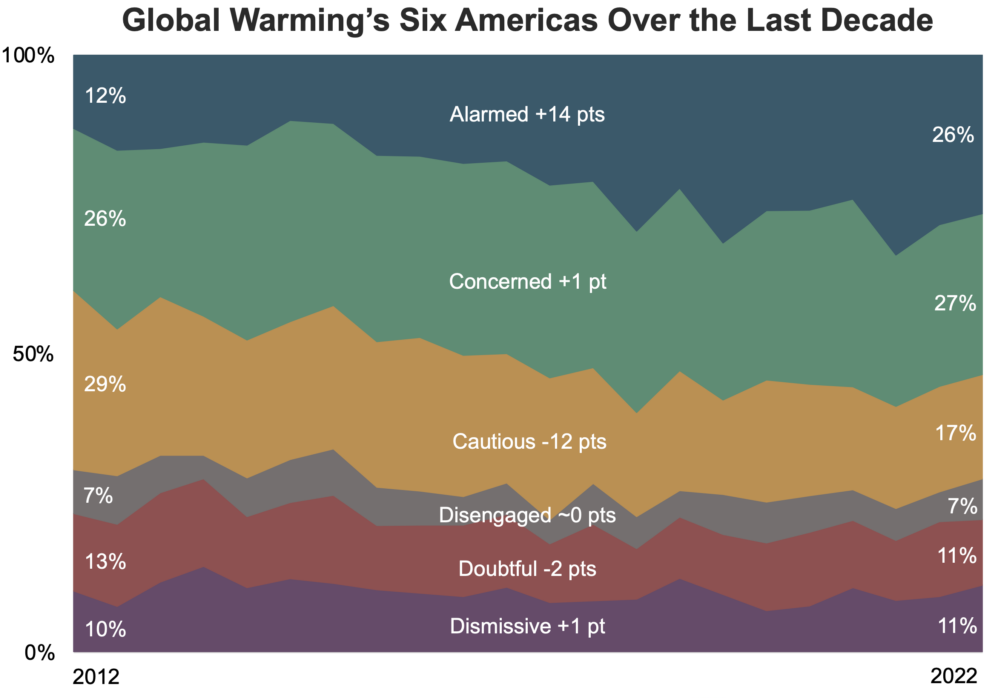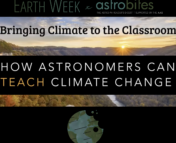All of us here at Astrobites are incredibly motivated in the realm of science communication. It is one thing to talk about astronomy, and it is wholly different to effectively communicate about climate change. Talking about this issue impacts each audience member or reader differently and uniquely. This means that those who wish to keep an effectual conversation going must learn how to adapt their communication strategy on a more resolved, individual level. During our Earth Week x Astrobites 2023 second session, Dr. Martin Storksdieck summarizes how Americans react to climate change content and how to mold your climate change communication to gain audience trust and best fit your goals.
What are Global Warming’s Six Americas?
Drs. Anthony Leiserowitz and Edward Maibach have led a project titled “Global Warming’s Six Americas” at Yale University that identifies six different ways Americans react to climate change content. These six simplified groupings – alarmed, concerned, cautious, disengaged, doubtful and dismissive – are influenced by an individual’s “psychological, cultural, and political” state (also shown in Figure 1):
- Alarmed – convinced that global warming is happening and is human-caused, strongly support climate policies, most do not know how to help
- Concerned – human-caused climate change is happening and is a threat, support climate policies, tend to believe its impact is in the distant future in a distant place
- Cautious – have not made up their minds, is climate change actually happening? Is it actually human-caused?
- Disengaged – are rarely in contact with climate change content and do not talk about it
- Doubtful – do not think global warming is happening or is serious, do not think much about it
- Dismissive – reject the idea of global warming, not human-caused, believe that climate change is a conspiracy theory meant to undermine what they believe in

Figure 2 shows how the percentage of Americans within each category has shifted from 2012 to 2022. Many of those who were “Cautious” moved towards “Alarmed”. This shows how the “Cautious” group ingested climate change content over ten years and learned of its significance. Those who are “Disengaged”, “Doubtful”, and “Dismissive” have roughly stayed that way.
Dr. Storksdieck broke down the six Americas into which questions are on the minds of those who fall into these categories:
- Alarmed – What can/should I do? How can I do it?
- Concerned – Why do I have to act now? And what are easy things I can do?
- Cautious – What is the overwhelming evidence? Convince me.
- Disengaged – Tell me more.
- Doubtful – Why should I pay attention?
- Dismissive – Why should I talk to you or trust you? What do we have in common?
Figure out which of the Six Americas you are! Take the quiz!

Catering Climate Change Communication
Because each group interacts with climate change content differently, a climate change communicator needs to cater their approach. Figure 3 shows what types of content each group is most willing to engage with. Those who are “Alarmed” or “Concerned” look for specific actions they can take to address climate change. The “Cautious” and “Disengaged” need an even spread of evidence, causes, consequences and actions. Concrete evidence and causes are needed by the “Doubtful” and “Dismissive”.
One of the reasons driving a lack of engagement – the unchanged “Disengaged” population from Figure 2 – is because climate change communicators tend to use too much jargon which can make the content less accessible. It may help in these cases to shift the conversation to more direct impacts of climate change on the local area, connecting with the audience on a more personal and close-to-home level.

Dr. Storksdieck’s six recommendations for climate communication, based on the “Six Americas”:
- Show interest in your audience’s opinions and thoughts.
- Ask your audience questions.
- Listen and learn from your audience.
- Take your audience seriously.
- Be nice.
- Do not try to win.
The first five recommendations indicate how important it is to establish a connection, a sense of trust and mutual respect between the communicator and the audience. It is imperative to align your communication with your audience’s views on climate change, so actively engaging with them and hearing their thoughts and stories will help you build the kind of approach you want to take.
The last recommendation – do not try to win – is to remain realistic and to protect the communicator from burnout. It is not likely that a climate change communicator will be able to completely shift a “Dismissive” person’s perspective. It is more effective to provide a more manageable step in the direction of accepting and addressing climate change. Whether that be by inspiring them to question their information sources, or think more critically about their local environment, etc, this can support a long-term shift.
Keep Hope Alive
Climate change is an especially fatiguing topic in a world already inundated with gloom and hopeless news. It is common to feel like nothing you do individually matters and/or to lose energy and the will to address climate change. When asked how we can reinvigorate this group of concerned-but-burned-out people, Dr. Storksdieck stressed celebrating the small successes and supporting larger structural change (i.e., vote for politicians who align with your climate change goals). The average American – and this maps to people around the world – exists within an environment that does not allow them to radically change their life to address climate change. Many people do not have the income or resources to completely halt consuming goods and services that contribute to global warming. While small individual choices do collectively make an impact – so yes purchasing that environmentally friendly detergent and taking the bus to work does help the planet! – it can often feel like a losing battle. So please keep in mind that if you are pushing for larger structural change in your nation then you are helping humanity take steps towards saving the world!
Here are some resources that discuss structural change in the US:
- Climate Insights 2020: Policies and Politics
- National Climate Task Force
- Science-based equitable policy from Our Climate
- Yale Climate Opinion Maps 2021 (policy support)
Interested in getting started in your climate change work? Go to terra.do! If you are an astronomer, join the Astronomers For Planet Earth!
A huge thank you to Dr. Martin Storksdieck for this session and for his work in addressing climate change!
Astrobite edited by: Roel Lefever
Featured image credit: Suchitra Narayana
Learn more about our Climate Change Series. We’d love to hear what you would like to see from this initiative – if you have ideas, please let us know in this google form. Find last year’s Earth Week page here.




